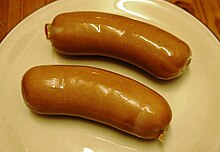Cervelat
The Cervelat [ ˈsɛrʋeˌla ] (from Italian cervellata and Middle French cervelat, from Latin cerebellum, the diminutive of cerebrum "brain") is a Swiss scalded sausage and has nothing to do with the Zervelatwurst known in Germany . Regions of Germany also belong to the traditional distribution area of the Cervelat, but there it is known by other names.
term
In some regions of Switzerland the Cervelat is also known as Cervelas (French-speaking Switzerland), Zervela, in Basel as Klöpfer or in St. Gallen also as Stumpen .
While the term Cervelas is used in French-speaking Switzerland , the German-Swiss spelling Cervelat is older, according to Le Robert Historique . This spelling appears for the first time in 1552 by François Rabelais . It goes back to the Milanese dialect word zervelada and the resulting Italian cervelato . In Switzerland, 160 million cervelats are produced annually, so the Swiss eat an average of 21 cervelats per year.
Composition and use
Originally it was a “large saucisse courte remplie de chair et de cervelle de porc” (thick, short sausage stuffed with meat and pork brain); today's basic recipe goes back to that of the people of Basel at the end of the 19th century.
The sausage mixture consists of roughly equal parts beef , pork , back bacon / ground rind and ice, as well as spices , curing salt and cutter aids . Today no more innards are processed into Cervelat. The ingredients are chopped up in a cutter , stuffed into natural casings (imported, mostly Brazilian, thin cattle casings), first smoked for around an hour at 65 to 70 ° C and then scalded at 75 ° C in a water bath or in a cooking cabinet.
The cervelat is prepared in a variety of ways, such as: B.
- grilled or fried (in halves)
- as part of the sausage salad or sausage cheese salad ("raw")
- "Raw" with bread and mustard or mayonnaise (also known as "Waldfest" or coll. "Vo Fuscht", from Faust)
- cut at the ends, put on a pointed branch and held over the embers
- sliced and fried
- cut lengthways, filled with cheese and wrapped in bacon (worker cordon bleu )
- warmed up in hot water.
- cut into pieces / slices and served with brown gravy (cervelat goulash)
Scarcity
From April 1, 2006 to autumn 2012 , no Brazilian beef intestines were allowed to be imported due to an EU import ban that also applied to Switzerland under the bilateral agreements . However, the intestines of Zebu cattle used for the Cervelat are more delicate and of smaller diameter than the European breeds and have some properties that made them suitable for the Cervelat when combined:
- They are firm enough to peel off easily on the raw sausage
- They are tender enough that you can eat them with the fried sausage
- They contract slightly when roasting, giving the fried cervelat its typical shape.
Since supplies were running low and no replacement was found that combined all of these properties, media reports said that the production of the Cervelat was threatened in the course of 2008. From August 2008, the supply was secured by imports from Argentina, Uruguay and Paraguay - as a replacement for Brazilian beef intestines.
Others
- In 1891 the Cervelat was mentioned for the first time in connection with the Swiss national holiday, the federal celebration on August 1st.
- "Cervelat celebrities " in Switzerland are denominated local celebrities that are less important to be classified, see also B celebrities .
- In the southwest of Germany, especially in the southern Palatinate around Landau in the Palatinate , the “Nussdorfer Cervelat” (also spelled “Nussdorfer Servelat”) is produced as a regional specialty, a sausage made from beef and pork, which is usually heated in hot water becomes.
Similar sausages
The specialty can also be found in southern Germany under the names Servela, worker chops and red sausages . In the Allgäu, in Upper Swabia, on the Upper Rhine and in Vorarlberg, people call Cervelat Schübling .
The well-known in Switzerland sausage Schüblig however, corresponds to the German bacon sausage ( Schübligziischtig / Schübeldonnschtig ).
See also
literature
- Heinz von Arx (Ed.): Cervelat. The Swiss national sausage . AS Verlag, Zurich 2015, ISBN 978-3-906055-38-1 .
Web links
- Cervelat / Cervelas in the database of Culinary Heritage of Switzerland .
- Mathieu von Rohr : Swiss intestinal alarm - national sausage in danger , in: Spiegel Online , January 16, 2008.
Individual evidence
- ↑ See Emil Steiner: The French loan words in the Alemannic dialects of Switzerland. Cultural-historical-linguistic investigation with an etymological dictionary. Wepf, Basel and Holzhausen, Vienna 1921, p. 336; Walther von Wartburg : French Etymological Dictionary . Volume 2, 1st half volume. Teubner, Leipzig / Berlin 1940, p. 603.
- ↑ a b Le Matin Dimanche . January 27, 2008, p. 25.
- ↑ a b sda: Import ban on beef casings from Brazil lifted. NZZ online, October 12, 2012.
- ^ Agathe Duparc: La Suisse panique devant une éventuelle pénurie de cervelas . In: Le Monde . January 21, 2008.
- ↑ Soon to be the end of the Swiss national sausage? , NZZ Online, December 29, 2007.
- ↑ The future of the Cervelat seems assured.
- ↑ Ruth Haener and Christian Thumshirn: Nationalwurst Cervelat: Why we love them hot. In: Neue Zürcher Zeitung from July 28, 2017.
- ^ Fritz von Gunten: Everything is sausage. On the Wurstweg through Switzerland. Ott, Thun 2006, ISBN 978-3-7225-0042-3 .



